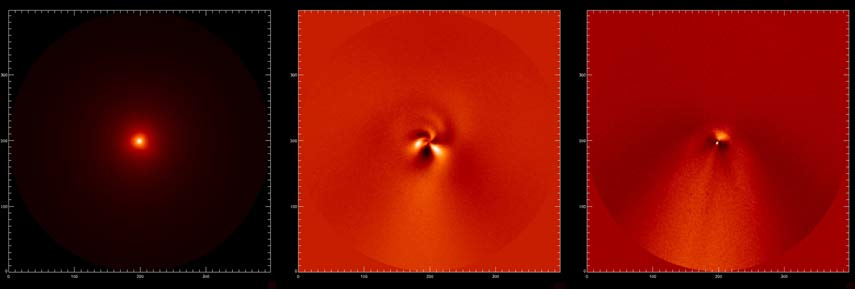New Photos Reveal Great Comet's Spiraling Jets

Astronomers have made rare images of the heart of a popular comet and revealed jets of gas spiraling thousands of miles into space.
Comet McNaught has been called the Great Comet of 2007 for the show it put on first in the Northern Hemisphere and then south of the equator. The ball of ice and dirt hung frustratingly close to the Sun, however, so many skywatchers never got a good look.
- Comet McNaught Images: Gallery 1 and Gallery 2
The New Technology Telescope (NTT) at the European Southern Observatory in Chile was used to make detailed observations that were released yesterday. Scientists found sodium in the comet's emissions, something rare in a comet, they said.
"We had previously pointed the NTT very low to observe the planet Mercury, which is very close to the Sun and is therefore only visible low in the sky just after sunset," said ESO astronomer Colin Snodgrass. "I realized that we could take advantage of the same low pointing limit to observe the comet while it was near the Sun."
The images reveal three jets of gas that spiral away from the comet's rotating nucleus.
"These jets are produced when sunlight heats ices on the surface of the comet, causing them to evaporate into space and create 'geyser' like jets of gas and small dust particles, which stretch over 13,000 km into space-greater than the diameter of the Earth-despite the fact that the nucleus of the comet is probably less than 25 kilometers [15 miles] in diameter," Snodgrass explained.
The comet releases dust, too. But the dust follows a different path from the gas jets, the observations revealed. The dust is tossed off the side of the comet facing the Sun, creating a bright fan of material that's blown back by the pressure of solar radiation.
Breaking space news, the latest updates on rocket launches, skywatching events and more!
Snodgrass and his colleagues hope to determine the comet's rotation rate by comparing images taken over time.
Separate observations called spectroscopy, which split light into its various wavelengths to reveal the comet's elemental composition, shows signs of cyanide, carbon, and ammonia-all expected.
The researchers were surprised to discover sodium, however.
"Measurements showed this sodium emission to be extending over more than 100,000 kilometers [62,000 miles] in the tail direction and fading rapidly with time," said ESO scientist Emmanuel Jehin.
Narrow sodium tails have been detected in only a handful of great comets-those that come close to the Sun and therefore are the most active.
"The dust grains are vaporized under the intense heat and start releasing sodium atoms which then react to the solar radiation and emit light-at the very same yellow-orange wavelength of the lamps on our streets," Jehin said.
Sodium has also been observed around Mercury and the Moon forming very tenuous atmospheres.
Comet McNaught was named for Robert McNaught, who discovered the object last year. At its peak, it was the brightest comet in four decades and was even glimpsed in broad daylight by some observers.
- The Greatest Comets of All Time
- Comet McNaught Images: Gallery 1 and Gallery 2
- Video: Comets Through Time ... Myths and Mystery
- Best Comet Images
- All About Comets

Rob has been producing internet content since the mid-1990s. He was a writer, editor and Director of Site Operations at Space.com starting in 1999. He served as Managing Editor of LiveScience since its launch in 2004. He then oversaw news operations for the Space.com's then-parent company TechMediaNetwork's growing suite of technology, science and business news sites. Prior to joining the company, Rob was an editor at The Star-Ledger in New Jersey. He has a journalism degree from Humboldt State University in California, is an author and also writes for Medium.
